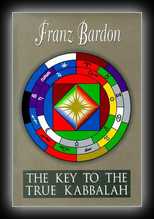
The Key to the True Quabbalah - The Quabbalist as a Sovereign in the Microcosm and the Macrocosm
by Franz Bardon
1986
The Key to the True Kabbalah is the third volume in the Bardon series of books on Hermetics. Many books have been written about the Kabbalah, but in practice very little can be used, since most of the original books were written in Hebrew. Therefore, it stands to reason that a person who practices the Kabbalah must have knowledge of Hebrew. This is now no longer the case. Once you have studied this book you will get an entirely different idea of the Kabbalah than what you previously had. Kabbalah is the science of the letters, of language and the word and not the language of the intellectual. It is the universal language.
From the Hermetic point of view a true Kabbalist is the highest initiate, for he represents the divinity in the microcosm. Therefore it is clear that a perfect Kabbalist must be a person who connects with God, a person who has realized God within himself and who, being a god-man, makes use of the universal language, whereby whatever he utters ! immediately becomes reality.
This book not only contains the theory necessary to practice the Kabbalah, but it also provides the step by step practice. Again, in order to be successful, the student must have completed the previous two volumes, Initiation into Hermetics and The Practice of Magical Evocation, otherwise he will fail. Most educated people possess knowledge, but no wisdom at all. Knowledge depends upon the development of the intellectual part of the spirit; wisdom, on the other hand, necessitates the balanced development of all four aspects of the spirit. A Kabbalist is the perfected sovereign in the microcosm and the macrocosm.
As in the two preceding volumes, Initiation into Hermetics and The Practice of Magical Evocation, The Key to the True Kabbalah will guide the student step by step through the exercises. Some writers make mention of the cosmic language which they sometimes term the Uranian language. It may well be that some letters of the cosmic langua! ge are known to and comprehended by them, but no one to thi! s day has written about it in detail. The cosmic language is the language of God, the language of Divine Providence.
In the practical part of Kabbalah, the reader is introduced to the mysticism of each letter. To save considerable time for those who are unfamiliar with the Hebrew alphabet, the regular Latin letters are used. Here each letter is expressed in a particular color. The student practices the visualization of each letter in its particular color, then in a particular part of the body, etc. He will also learn to which element each letter belongs, for example the letter A belongs to the element of air. All this knowledge is very important to the student, otherwise he will not be effective as a Kabbalist.
Also the ten Kabbalistic keys are explained, and an explanation is given as to their significance. The student will also learn how to pronounce the letters into the Akasha principle, and the mental, astral and material spheres. This will release the effects that t! he letter contains. And with the next step he will enter into the practice of formula magic which begins with the Kabbalistic alphabet of the two-letter key. For example, the two-letter key B-I is a Kabbalistic formula. With this formula it is possible to remove from one's consciousness any painful memory, unpleasant experience or unnecessary pangs of conscience.
